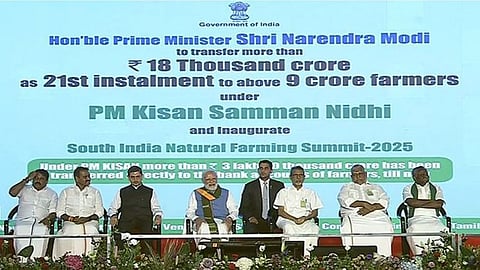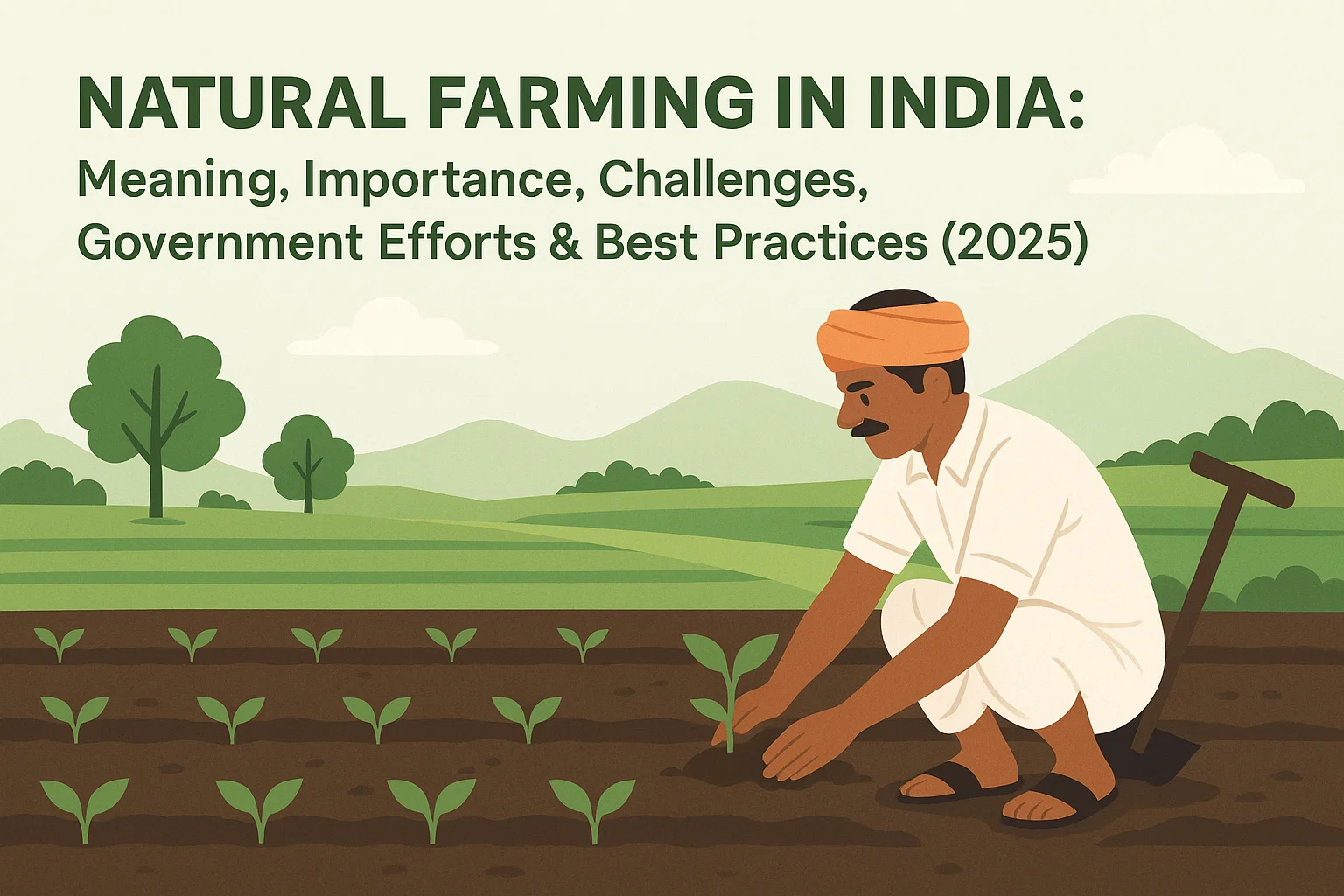Natural Farming in India: Meaning, Importance, Challenges, Government Efforts & Best Practices (2025)
Explore Natural Farming in India—its definition, principles, benefits for soil health, climate resilience, and farmer income. Understand key challenges, government initiatives like the National Mission on Natural Farming (NMNF), PM-KISAN support, and global plus Indian best practices to scale sustainable agriculture in 2025.
Natural Farming in India:
At the South India Natural Farming Summit 2025 in Coimbatore, Prime Minister Narendra Modi announced that India is poised to become a global hub of it, citing the urgent need to restore soil degraded by excessive chemical inputs. He also released the 21st instalment of PM-Kisan, transferring ₹18,000 crore to farmers.

What is natural farming?
- Definition: A holistic farming practice that avoids synthetic fertilisers, pesticides, and genetically modified seeds.
- Principles: Relies on locally available resources—cow dung, cow urine, compost, biofertilisers, mulching, crop rotation, and mixed cropping.
- Approach: Enhances soil fertility, biodiversity, and resilience by working with natural ecological processes rather than against them.
- Examples include Zero Budget Natural Farming (ZBNF), Rishi Krishi, and organic farming movements inspired by scientists such as G. Nammalvar.
Why is it essential?
- Soil Health Restoration: Decades of chemical fertiliser and pesticide use have degraded soil structure and fertility; NF can rebuild organic carbon and soil microbiome.
- Reducing Input Costs: By using on-farm inputs and reducing dependence on purchased synthetic inputs, NF helps reduce cultivation costs.
- Climate Resilience: This practices improve water-holding capacity, making farms more resilient to droughts or floods.
- Health and Food Safety: Chemical-free produce reduces risks from pesticide exposure; NF promotes safer and nutritious food.
- Biodiversity and Ecosystem Health: Using diverse cropping systems and integrating livestock fosters on-farm biodiversity.
- Revival of Traditional Knowledge: NF revalues indigenous practices (e.g., Panchagavya, mulching) and integrates them with science.
What are the major concerns associated with it?
- Transition Period: Shifting from conventional to natural farming can take time; soil organic carbon, local ecology, and prior practices affect the pace.
- Input Availability: Farmers need ready access to bio-inputs (Jeevamrit, Beejamrit) — thus the need for Bio-input Resource Centres.
- Certification & Market Linkages: Chemical-free produce needs credible certification and a brand so farmers can sell at a premium; not all farmers are tapped in.
- Capacity Building: Large-scale adoption requires training (Krishi Vignan Kendras, Model Farms, Master Trainers).
- Scale and Funding: The mission’s reach (1 crore farmers, 7.5 lakh ha) is ambitious and needs sustained funding & support.
What efforts have been taken to address these concerns?
- National Mission on Natural Farming (NMNF): Launched to scale up natural farming practices nationwide, focusing on reducing chemical fertiliser use, promoting bio-inputs, and ensuring certification models like CETARA-NF for credibility.
- PM-KISAN Direct Support: Over ₹4 lakh crore has been transferred directly to farmers’ accounts, with recent instalments (₹18,000 crore) earmarked to support the adoption of natural farming methods.
- Science-backed movement: PM Modi emphasised making natural farming a fully evidence-based practice, integrating agricultural scientists, startups, and innovators to strengthen credibility.
- Awareness & Farmer Training: Summits like the South India Natural Farming Conference and Krishi Vigyan Kendras provide training on practices such as Panchagavya, Jivamrut, Bijamrut, and Achhadan, which improve soil health and reduce input costs.
- Budgetary Push & Policy Integration: The Union Budget 2024–25 highlighted promotion of this practice among one crore farmers, establishment of bio-input resource centres, and integration with climate-resilient crop strategies.
- Soil Health & Certification: Schemes like the Soil Health Card and farmer-producer organisations (FPOs) are being aligned with natural farming to ensure traceability, quality assurance, and market access.
What are some of the best practices that can be adopted to augment natural farming further in this country?
-
Global Practices:
-
-
- Latin America’s agroecology networks: Farmer-to-farmer knowledge sharing, participatory certification, and community seed banks.
- Permaculture in Oceania: Designing farms as self-sustaining ecosystems with water harvesting, mixed cropping, and perennial plants.
- EU Green Deal & Farm to Fork Strategy: Targets 25% of farmland under organic/natural farming by 2030, backed by subsidies and certification systems.
- African push for biofertilisers: Use of compost, biochar, and microbial inoculants to restore degraded soils and reduce dependence on imports.
-
-
Indian Practices:
-
- Zero Budget Natural Farming (ZBNF) in Andhra Pradesh: Large-scale adoption using cow dung, cow urine, and bio-inputs; supported by state policy and farmer training.
- Sikkim’s 100% organic farming model: First fully organic state, showing how certification, branding, and tourism can boost farmer incomes.
- National Mission on Natural Farming (NMNF): Launched in 2024, promoting natural inputs, crop diversification, and farmer training through Krishi Vigyan Kendras.
- Tamil Nadu’s millet-focused natural farming: 35,000 hectares under natural farming, with emphasis on climate-resilient minor millets.
Subscribe to our Youtube Channel for more Valuable Content – TheStudyias
Download the App to Subscribe to our Courses – Thestudyias
The Source’s Authority and Ownership of the Article is Claimed By THE STUDY IAS BY MANIKANT SINGH

